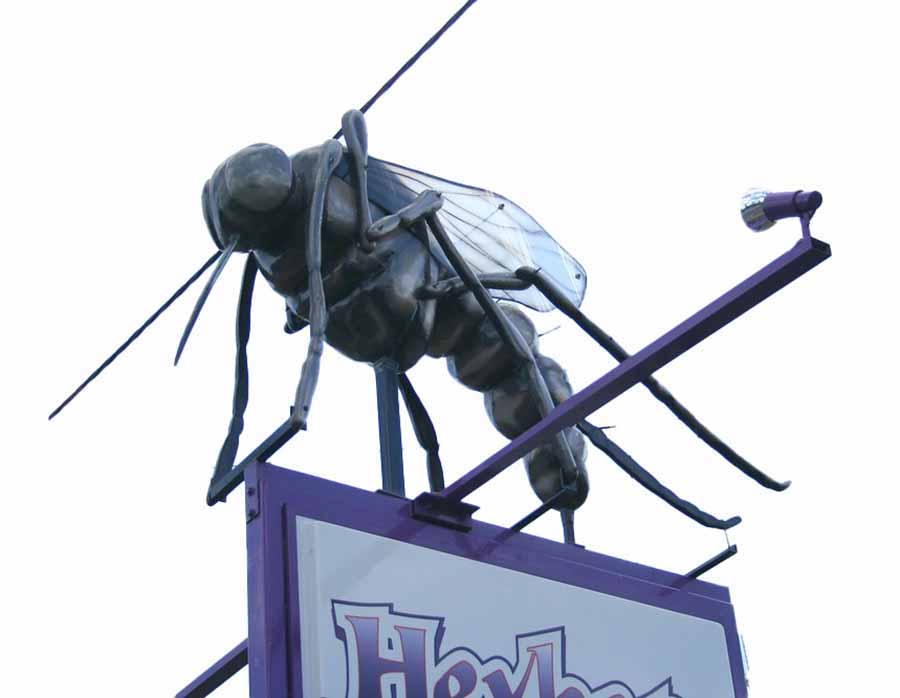
Most mosquito bites are annoying, but not deadly. Keeping them at bay is an important part of a holiday. Even in popular European destinations there are over 50 mosquito species.
Mosquitoes are the deadliest threat to humans, causing an estimated 2.7m deaths per year, with most victims being children.
There are approximately 3,500 different species of mosquitoes worldwide. In his book The Mosquito: A Human History of Our Deadliest Predator, author Timothy Winegard estimates a global mosquito population of around 110tn, with some estimates in the quadrillions. Mosquitoes are virtually impossible to count accurately due to their short lifespan.
Female mosquitoes can live up to nine weeks, while males only live up to 10 days. Countries in Africa have the highest rates of malaria deaths due to high mosquito populations. The top ten in order of deaths are Burkina Faso, Benin, Liberia, Mali, Central African Republic, Sierra Leone, Democratic Republic of Congo, Niger, Mozambique, and Guinea.
Brazil, Indonesia, Australia, and the Philippines have the highest populations of mosquitoes, while Brazil, Indonesia, Malaysia, and Thailand have the most mosquito species. Australia has 231 species, India 338.
World’s most dangerous animal
Mosquitoes, which means “little fly” in Spanish, have been on Earth for over 100m years. They have fed on velociraptors by inserting their proboscis into them.
Mosquitoes are considered the world’s most dangerous animal, as they transmit diseases such as West Nile virus, dengue fever, encephalitis, and especially malaria. Malaria, spread exclusively through mosquito bites, infects 247m people annually and results in one million deaths, according to the World Health Organisation. Even Ireland once had malaria. In one of the ironies of history, Oliver Cromwell died in 1658 as a result of a mosquito bite he acquired in Cork.
Only a few species transmit diseases to humans—about 12 species cause most human. Only female mosquitoes bite in order to nourish their eggs with the protein found in blood. They are efficient hunters, homing in on their prey like a missile. They detect carbon dioxide from breath up to 35 meters away and follow a zigzag course to locate the source with higher concentrations. As they approach, they rely on cues such as body odour, heat, and sight. Mosquitoes are attracted to perfume and the scent of bacteria found in Limburger cheese, as well as stinky feet.
When mosquitoes are approximately three meters away, they use thermal receptors on their antennae to locate blood below the skin surface. The range of these receptors triples in high humidity. Black flies create a messy crater and then drink the pooling blood, while mosquitoes insert a straw through the skin to both inject an enzyme that prevents clotting and suck up the blood.
A mosquito can consume up to three times its own weight in blood. It would take a million bites to completely drain the blood from a human body. In one instance, a researcher received 289 mosquito bites in a minute by putting his bare arm into a cloud of mosquitoes, while another individual had 125 mosquitoes on one hand in just five minutes.
Mosquitoes are more attracted to women than men due to differences in hormonal scent, and they are even more drawn to pregnant women, possibly because of their higher body temperature. Increased movement in a potential prey can also lead to more mosquito bites, as restless individuals are targeted more often. Trying to dodge around to avoid a few mosquitoes may actually result in getting bitten more.
Bella luna
Mosquitoes are most active during the full moon and their wings beat an astonishing 300 to 600 times per second, which is 120 times faster than a hummingbird. The high-pitched whine produced by their wings varies in pitch among species but typically falls between middle C and F.
Female mosquitoes can lay between one and four clutches of eggs in a summer season. In the high Arctic, some species do not require blood until after laying the first batch of eggs, so it is possible to avoid being bitten early in the season. Caribou can lose up to 300 milliliters of blood per day to mosquitoes.
While a mosquito’s feeding system operates like a hypodermic needle, it is important to note that it is impossible to contract AIDS from a mosquito bite. This is because the mosquito digests the AIDS virus along with the rest of the blood it consumes. Even in the scenario where a mosquito feeds on an individual with AIDS and then bites someone else, the saliva injected has never come into contact with the previous blood meal.
Some towns even celebrate mosquitoes, such as the World Mosquito Killing Championship held annually in Pelkosenniemi, Finland. Competitors aim to kill as many mosquitoes as possible in five minutes, with the winning total usually around 27. Additionally, Clute hosts the Great Texas Mosquito Festival each year, and Komarno in Manitoba features a giant statue of a mosquito.
In Australia the Hexham swamp mosquito was celebrated in a poem by banjo Patterson, author of Waltzing Mathilda, the quasi national anthem of Australia, a frequent visitor to Ireland and cousin of the Bartons of Straffan House. Nowadays as you approach Hexham, a suburb of the city of Newcastle, northern New South Wales, you are confronted with an outsize mosquito, a roadside attraction standing on the Pacific Highway. It was added to the town’s landscape in 1994.
Arctic circle
Types of mosquitoes, resistant to the cold, can be found in the high Arctic, in Scandinavia, Siberia and north America. Recently, residents of Grise Fjord in Canada, usually free of mosquitoes, have observed a few flying scouts in recent summers.
According to Inuit legend, there were originally only two mosquitoes, tall as pine trees, that would swallow people whole. The men eventually surrounded and killed them, but swarms of tiny replicas emerged from their spilled blood and bite us today as revenge.
A certain saint, banished from heaven for disobedience, was sentenced to live alone in an uninhabited part of the world for eons. In her solitude, she prayed for a few flies to keep her company, unaware that they would bite. When the saint was eventually allowed back into heaven, the flies remained on Earth as a reminder of the consequences of trying to distract ourselves from the realities we have created.
At the Governor’s Mansion in Juneau in Alaska, there is a totem pole that was carved in 1939–1940. It features the figures of a mosquito and a man near the top, portraying the Tlingit legend of the cannibalistic giant, Guteel, and his capture by hunters in a pit. Guteel warned his captors as he was dying that even though they killed him, he would continue to plague them by biting. His ashes rose into the air and transformed into mosquitoes, fulfilling his ominous promise.
DEET dreams
When it comes to repellents, DEET has been considered the top choice since 1957. Originally developed by the US military post-World War II, it was believed to interfere with the insects’ senses to prevent them from biting. However, recent studies indicate that DEET actually functions as a true repellent, as mosquitoes simply detest the scent of the chemical, despite it not affecting their ability to detect carbon dioxide.
DEET is available in various forms such as sprays, oils, roll-ons, and lotions, each with different strengths. While 100pc DEET products can still be purchased in the USA, Canada restricts consumer products to 30pc. Higher concentrations of DEET do not necessarily provide better repelling abilities, but they do last longer.
Another repellent known as Picaridin was created in the 1980s and is said to be equally effective as DEET but is not as widely accessible. Unlike DEET, Picaridin does not cause damage to items like sunglasses or watch straps.
Numerous traditional and modern repellents claim to ward off biting insects, but none are as effective as the officially tested products. For instance, Citronella only works for a short duration, while Avon Skin So Soft moisturizer is renowned for its accidental repellent qualities but does not offer long-lasting protection. Ultrasonic devices, bug zappers, Vitamin B tablets, garlic, and bananas have shown limited effectiveness. Interestingly, drinking beer seems to make individuals more appealing to flies.
In the past, mesh bug jackets were treated with DEET, but as they are now chemical-free, they serve as a barrier against insects. These jackets are effective as long as the material is kept away from the skin. While flies may not be able to pass through the mesh, they can still use their biting mouthparts to penetrate the fabric and reach the skin. Designing clothing that effectively blocks insect bites while remaining comfortable on hot summer days is a challenging task.
Blackflies are as bad
Mosquitoes typically hatch in stagnant water, while black flies prefer flowing streams. Female black flies lay their eggs (ranging from 150 to 600 per season) on objects submerged in water. The larvae of black flies attach themselves to rocks and underwater vegetation, where they filter feed on drifting nutrients. These insects are sensitive to environmental pollution, so the presence of black flies often indicates clean water sources.
Black fly populations tend to increase towards sunset, but they do not typically bite at night. Canadian black fly species do not usually venture indoors. In some cases, black flies can swarm cattle in such large numbers that it can result in death due to anaphylactic shock, not blood loss. The saliva that black flies inject to prevent blood clotting can have adverse effects on sensitive individuals, particularly after multiple bites.
Black flies are skilled at locating exposed areas of skin and can maneuver through even the smallest openings in clothing. They tend to target areas such as ears, scalps, wrists, ankles, the belt line, and other spots where clothing fits tightly against the skin.
There are 65 different species of black flies found in Canada. The most common species found in barren lands is known as the “tormentor,” while another species in northern regions is referred to as “irratum,” showcasing the personal touch that scientists sometimes include in naming these creatures.
In 1971, black flies were responsible for the death of 973 cattle in northern Alberta. Even the surviving cattle experienced an average weight loss of 45 kilograms each. The “Black Fly Song,” composed by Wade Hemsworth, has become popular in Canada. Remarkably, up to 42pc of black fly species managed to survive the ice age, reflecting their resilience as a species.
Dim the lights
To keep mosquitoes away, experts at WinstonsBeds recommend avoiding strong scents, keeping rooms cool, dimming lights if windows are open, and wearing long sleeve clothing.
- Avoid strong scents. Mosquitos can be attracted to strong scents so stay away from scented perfumes and lotions before bed. It’s also worth checking the hotel room for any air fresheners.
- Keep the room cool. If you have air conditioning available in your accommodation then try to keep the room cool to prevent mosquitoes from entering. They’ll typically be drawn to warmer environments.
- Keep the lights off if the windows are open. Mosquitoes are attracted to lights so it’s worth dimming lights or keeping them off if you have any windows open.
- Consider long sleeve clothing. You can minimise the risk of being bitten by mosquitos by opting for pyjamas with long sleeves and trousers. Make sure the material is lightweight and breathable to avoid getting too hot in the night.
- Use lavender. Mosquitoes hate lavender so it’s worth applying some to your wrists, backs of knees and arms before going to sleep. You can also dab some on the edges of the windows to prevent them from entering.
It is important not to itch mosquito bites to prevent infection.

Outsize mosquito in Hexham, NSW



